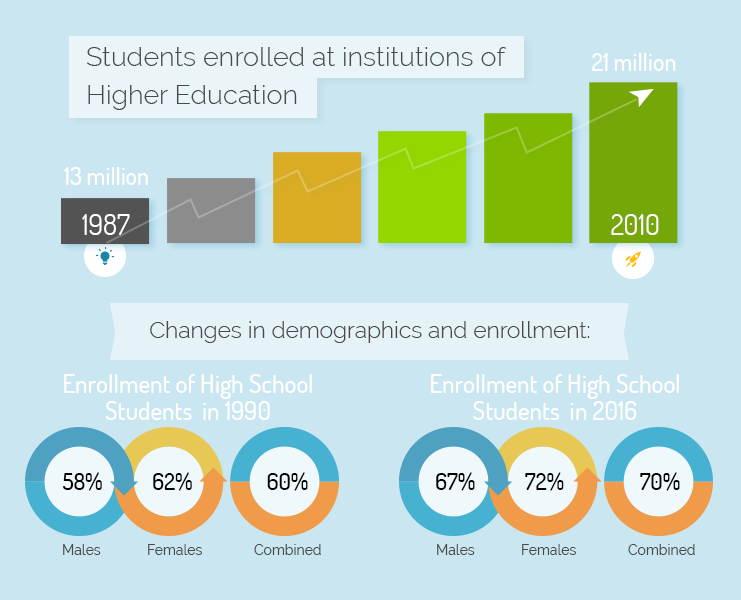College Access Is No Longer The Primary Focus
Decades ago, higher learning institutions were out of reach for many. Access and affordability were the top concerns. Either the admission policies were too stringent, there were limited ways to pay for an education, or the costs simply out of reach. Many opted to immediately enter the workforce upon graduation and/or begin families.
So much has changed since then. Major shifts in enrollment, student demographics, and funding now require higher learning institutions to change course or be left behind. Much of the driving force behind this evolution is the fact that graduates are now competing for jobs with candidates from around the globe. A post-secondary education is no longer bragging rights but a requirement for the more desirable, higher paying jobs.

Clearly, accessibility is no longer a barrier to entry. Higher learning institutions are shifting their focus from providing access to student outcomes and success.
One of the most proactive and self-sustaining actions an institution can take is to bridge the gap between academics and IT. These typically siloed departments must work together to build the internal structures required to deliver the modern education students demand. These students have been raised on technology. They expect the institutions to whom they pay will prepare them for these jobs using the technology they are accustomed to in order to quickly perform tasks and monitor their progress throughout their educational journey. This is how students succeed. This is how institutions improve student outcomes.
Student Success Is The Driving Force
Today, it’s no longer a goal to boost enrollment numbers. With performance-based funding front and center, success rates have taken precedence. It’s pretty simple math: higher performing institutions get more funding than lower performing schools. How do we now measure performance? At the most basic level, it comes down to graduation rates.
Despite all of the efforts to improve student outcomes, it doesn’t appear they are having much effect. For students entering college in 2008, about 60 percent of them earned a bachelor’s degree within six years. For those entering college in 1996, graduation rates were just over 55 percent.
A five percent increase in graduation rates in more than a decade isn’t very impressive. Accessibility was a much simpler beast to tackle. What does it take to ensure more college students graduate and achieve the outcomes higher learning institutions so desperately need to push?
Many college systems put all of their eggs into the technology bucket, investing in giant ERP systems to digitize business processes and crunch numbers. While the data is being tracked and stored databases, little has been done with the information to move the needle.
That’s why increasingly more institutions are beginning to move beyond ERPs to focus on software to solve specific problems in order to maintain performance-based funding to simply survive. Most of the challenges they are trying to address are centered around student success – helping students graduate on time and within budget.
Balancing Admissions with Student Outcomes
There is a sweet spot for higher learning institutions. It lies somewhere between admissions and on-time graduation, and it involves both a change in perspective and an investment in modern technology.
The student population has changed nearly as drastically as the technology required to support them. Today’s college student is just as likely to be a mother, father, or full-time worker as they are a recent high school graduate. Students of all demographics are asking for flexibility, not simply accessibility. They want college on their own terms, on their own schedules.
Just as important is their desire to use the technology they are using in their everyday lives to navigate the post-secondary journey. For these tech-savvy students, standing in line to make a financial aid payment or to visit an advisor to drop a class is akin to referencing an encyclopedia for current information. It’s archaic, inefficient, and frustrating. They can do virtually everything on their mobile device…except perform the very tasks they need to succeed in college.
Students want to take control of their own journey and they expect to be able to do it from the mobile devices they carry with them everywhere they go. Yet, it’s more than just giving students a mobile app. It’s about giving them access to their student information so they have real-time insight to make decisions in their own interest and in their own time.
Higher learning institutions must put today’s student first, understanding where they are coming from, what they want and need to succeed. Most importantly, it’s realizing today’s student is vastly different from students even a decade ago. Institutions must meet students where they are if they truly want them to succeed.
4 Areas of Focus for Today’s Institutions and Students
When institutions combine the philosophy of “students first” with the technology to enable them, they position themselves and the student to maximize outcomes. Where should higher learning institutions concentrate their focus? When they commit to these four areas, everyone wins.
- Student engagement and communications
- Student experience
- Guided pathways and on-time graduation
- Financial aid efficiency and compliance
What does it take for an institution to be student-ready? The academic side of the institution must come together with the technology side. Both must recognize their dependence on each other to bring the institution into modernity – to give students everything they now require, not simply want, to achieve the best outcomes. Student success, necessary funding, and long-term institutional viability are riding on it. In a nutshell, the investment is worth it.
Technology and academics can be (must be) combined in a smart way to give students the ability to make their own decisions. Students want to have a voice. They are spending tens of thousands of dollars for an education they believe will prepare them for today’s workforce. If the institution isn’t providing the latest technology, how can they possibly graduate workforce-ready students?
In a series of upcoming blogs, we will discuss in detail each of these four areas institutions must master if care at all about student success. Each area is critical to providing the best user experience so we plan to guide you through it without bias.
This is where education is heading. This is where we will finally see graduation rates improve beyond 60 percent. It’s time to modernize college campuses to give students the tools they need to succeed in today’s competitive market. When students succeed, institutions succeed. It’s a win-win, but it requires buy-in from both academics and IT. We’ll show you how to build the synergy you’ll need to make it a reality.




